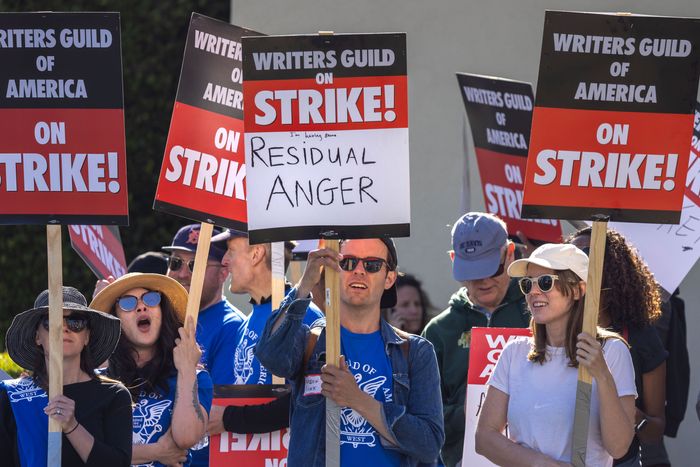
The writers’ room wasn’t getting paid enough to define the WGA strike’s terminology, so we took a stab at it. With the Writers Guild on strike, observers are catching up on the industry jargon that comes along with the coverage and negotiations. Most of us know that union film and TV writers are fighting for better compensation, AI regulations, and protections from exploitative new streaming practices like “mini-rooms,” but what are mini-rooms? Glance at the full document of WGA proposals and the AMPTP counteroffers, or the expired union contract, and you’ll be left wondering what a “span” is — and maybe even AMPTP and WGA. The Screen Actors Guild authorized a strike, beginning midnight on July 14. Just what is SAG-AFTRA talking about in its proposal? Why does everyone keep calling SAG-AFTRA’s interim agreements “waivers” even though the agreements are contracts that agree to the union’s terms? Well, get the 411 on the 6/5/5 below.
First, let’s start with the basics.
AMPTP
Alliance of Motion Picture and Television Producers. The AMPTP is a trade association that represents over 350 American film and TV production companies in negotiations with labor unions, including the WGA, the Screen Actors Guild (SAG-AFTRA), and the Directors Guild of America (DGA).
Artificial Intelligence
As Hollywood adopts the fad-technology frontier that is artificial intelligence, unions fear studios eager to cut costs and line shareholders’ pockets will not hesitate to replace them with machine learning. To combat this reality, the guilds seek to regulate the use of AI in union-covered projects. The WGA demands that AI cannot produce original material, rewrites, and source material, nor can union-covered material be used to train machines. The AMPTP rejected the WGA’s proposal and countered with an offer to hold annual meetings to discuss technology.
AI is a major sticking point for SAG-AFTRA as well. The union is bargaining for protections against the misuse of generative AI technology that can mimic voices, likenesses, and performances. Their proposals include ensuring consent and fair compensation for work that can be used in machine learning.
Equity
Britain’s performing-arts and entertainment trade union representing more than 51,000 actors, singers, dancers, designers, directors, stage managers, puppeteers, comedians, voice artists, and variety performers. Because SAG-AFTRA’s strike is not lawful under United Kingdom law, members of SAG-AFTRA’s British counterpart working in the U.K. are required to continue work. If an Equity performer joins the strike or refuses to cross the picket line in the U.K., then they will have no legal protections against breach of contract lawsuits or dismissals, according to the statement from the general secretary of Equity, Paul W. Fleming, titled “Solidarity Statement and Advice Regarding SAG-AFTRA Industrial Action 2023.” In addition, Equity advises its members to continue to show up to set. As a result, studios can exploit British law to keep actors working despite the strike because actors and staff do not fall under local strike rules. HBO shows including House of the Dragon and Industry will keep shooting in the U.K. this summer, per Variety. Meanwhile, the Dune prequel Dune: The Sisterhood will continue production in Budapest, Deadline reports.
Interim Agreements
A 70-page contract between SAG-AFTRA and independent producers wherein both parties agree to the terms and conditions in the union’s last offer to studios. The contract, only available to independent producers, allows actors to continue working on productions and promote films that meet SAG-AFTRA’s demands. The union specifically encourages members to promote films under interim agreements at fall festivals, including the Venice International Film Festival, Telluride Film Festival, and Toronto International Film Festival, and stresses that this activity is not strikebreaking. Interim agreements are not new, SAG-AFTRA notes. The bargaining tool was used in the 1960 and 1980 TV/theatrical strikes and for the 2000 commercials strike. SAG-AFTRA believes the interim agreements will put pressure on studios by demonstrating that their demands can be met even by independent producers and making the distribution of these projects unfeasible on streaming services until the strike ends. The union notes that an interim agreement is not a waiver, nor is it intended to prolong the strike.
Residuals
The compensation earned from reuse of material. Residuals, the compensation earned from reuse of material, for theatrical releases, daytime serials, free TV programs, basic cable programs, made-for-DVD projects, and other classifications are calculated differently. Streaming residuals are not at the same level as broadcast nor rewarded for success. If a show has 1 million viewers and is a streaming hit or bombs with zero, the writers’ residuals remain the same. The WGA demands an increased fixed residual and the establishment of a viewership-based residual to reward successful shows. The AMPTP rejected their proposal.
SAG-AFTRA shares the WGA’s belief that undercutting residual payments in our current streaming system fails to reflect the economic value of an actor’s product. The actors union demands fair and meaningful residuals that are a source of good income for performers to achieve and maintain a middle-class lifestyle.
SAG-AFTRA
Screen Actors Guild–American Federation of Television and Radio Artists. SAG-AFTRA is a labor union representing approximately 160,000 actors, announcers, broadcast journalists, dancers, DJs, news writers, news editors, program hosts, puppeteers, recording artists, singers, stunt performers, voice-over artists, and other media professionals. Though the union represents a plethora of entertainment-industry roles, it is film and television performers who are currently on strike.
Self-Tape Auditions
Uncompensated audition tapes self-produced by actors. SAG-AFTRA argues that the rise of unregulated self-taped auditions, a major sticking point in negotiations, creates undue burden on the lives of performers and an environment where workers are exploited, saying that the current system takes too much time and has unreasonable requirements. Performers are bearing casting costs that were once the responsibility of producers. The union demands that the AMPTP agree to rules and limitations for self-tapes, while also creating access to other casting formats to ensure fairness.
Staff Writer
An entry-level TV-writing position. This role is protected by the WGA, unlike the junior support staff, including writers’ assistants and writers’ production assistants, who are represented by separate collective bargaining agreements or are nonunion. Staff writers develop and break a story in a writers’ room. They are not often assigned to write an episode’s script, so their work is unlikely to result in a “teleplay by” credit. As a staff writer moves up in the writers’-room ladder, the next role is story editor, followed by executive story editor, co-producer, producer, supervising producer, co–executive producer, and then showrunner.
WGA
The Writers Guild of America. The WGA is a labor union representing approximately 20,000 writers in film, TV, documentaries, news, animation, video games, and new media.
Writers’ Room
An office where TV writers develop and break a story. Writers brainstorm and pitch ideas, outline episodes, and workshop seasons. Writers’ rooms vary in size and duration based on the needs of the show and financial decisions made by studios. Rooms are staffed, on average, by around seven writers with extended contracts.
And now, here’s language you’ll see in the negotiations.
2nd Step
A screenplay deal where the writer is hired for the first draft and one rewrite. Screenplay deals can be broken down into categories based on how many times a writer touches the script. A one-step deal is where a studio hires a writer to produce a single draft of a project. Writers are wary of one-step agreements because they are less profitable unless a studio calls them back and agrees to pay for revisions. Two-step deals, on the other hand, pay the writer for two drafts, giving them the opportunity to have more control over the finished product — and a better paycheck. The WGA demands include a “guaranteed 2nd step” provision for feature films if a studio hires them to write for less than 250 percent of the minimum compensation for a screenplay. The AMPTP rejected the WGA’s proposal.
6/5/5
The percentage minimum increase demanded. The guild is asking for a 6 percent–5 percent–5 percent increase on all minimum bases (see below), including residuals, over the course of the three-year contract — meaning the minimum would increase by 6 percent the first year the contract is ratified, 5 percent the second year, and 5 percent the third year. Studios came back to the table with a 4 percent–3 percent–2 percent increase on minimums and a onetime raise of residual bases by 2 or 2.5 percent.
Appendix A
The rates and guarantees for episodic television outside of prime time, quiz shows, comedy-variety programs, documentaries, and news programs. The WGA proposes extending Appendix A terms to high-budget shows made for SVOD (subscription video on demand), including weekly minimums, 13-week employment guarantees, and residuals based on aggregate. The AMPTP countered with the offer to only apply Appendix A terms to SVOD comedy-variety programs with no aggregate residuals or 13-week guarantees. Under this agreement, writers would be paid a daily rate — a proposal that does nothing to defend against the criticism that writing is now a gig economy.
AVOD
Advertising-based Video on Demand. Platforms like Tubi, Pluto TV, Roku Channel, Freevee TV, and Crackle function like broadcast television, and writers would like to be compensated as such. For high-budget programs made for AVOD, the WGA demands that union members get TV weeklies, script fees, and improved residuals. The AMPTP rejected the proposal.
Development Room
A writers’ room established before a series or season order. The WGA proposed that “greenlight rooms” are paid at a 25 percent premium. The AMPTP countered with a 5 percent premium for development rooms, the terminology it used to describe a green-light room. Its premium applies when three or more writers are hired for ten weeks or fewer before the first season of a series.
ESE
Executive story editor. ESEs are mid-level TV writers who receive a per-episode fee and payment for any “story by” or “teleplay by” credits. 6/5/5 increases would apply to ESE weekly rates if the studios agree to demands.
Financial Core
Nonunion members who pay reduced WGA dues in exchange for union benefits. They cannot vote or hold guild positions. Also known as “fi-core,” these writers are excluded from awards consideration and are not called to strike due to their nonunion status. During the 2007–8 strike, 28 writers opted to resign from the WGA and apply for fi-core status to keep working. The WGA publicly identified the writers at the time, who mostly worked on soap operas.
Force Majeure
A clause in the contract that frees one or both parties from their contractual obligations if an extraordinary event prevents them from performing their duties. Ahead of the writers’ strike, the Association of Talent Agents sent its members a 22-page summary of the WGA, SAG-AFTRA, and the DGA’s “force majeure” provisions in anticipation of the clause being used to suspend or terminate deals while shows are on pause. The report notes that, in the event of a WGA strike against any company, a writer’s own employment contract is automatically suspended. Upon termination of the strike, the writer may resume their duties with the same terms and salary at the request of the company.
HBSVOD
High-budget subscription video on-demand programs. These programs stream on services like Netflix, Hulu, and Disney+. In the expired contract, HBSVOD residuals are “fixed” residuals, meaning the amounts are set in the MBA and calculated by the size of the streaming service’s subscriber tiers. Residuals are paid annually and decline over time, with an additional payment for internationally licensed programs. The WGA demands new tiered HBSVOD residuals based on a streaming service’s foreign-subscriber count.
The AMPTP counteroffer bases HBSVOD residuals on foreign-subscriber counts for only the biggest streamers, while Max and Paramount+ continue to pay the lower license-fee-based residual. The two parties agreed to pilot and backup script premiums for HBSVOD programs.
MBA
Minimum basic agreement. The MBA is the collective bargaining agreement, or the contract, that the WGA enters with studios (i.e., the AMPTP) to cover the benefits, rights, and protections of guild members and their work. Deadlocked negotiations over the current MBA, a deal that is ratified every three years, led to the strike. Because the two parties were not able to agree on terms, the WGA allowed the contract to expire and called for a strike.
Minimums
Refers to the minimum rates stipulated by the union contract. Minimums vary based on the type of media, budget, and job title. Ninety-eight percent of TV staff writers work for the union minimum, up 12 percent from the 2013–14 season. Around half of all showrunners are paid at the minimum, up 16 percent. The WGA demands that studios agree to an across-the-board minimum increase.
Mini-rooms
This is a relatively new industry practice of shrinking writers’ rooms by employing two to three writers to work with a showrunner on a short-term basis in advance of the production of a TV series. Though streamers typically take advantage of this model today, it was smaller budget cable television that birthed the practice with series like AMC’s Mayfair Witches or Kevin Can F*** Himself to outline a story before a show is green-lit, per Variety. Because mini-rooms often break down a season and structure before a show is green-lit or renewed, writers are paid the union minimum (and not their typical fees) over a short period — and sometimes may not return to the series even if the studio okays a series order. Writers’ rooms, on the other hand, typically have longer employment durations and are staffed by seven or more writers. The mini-room reality led to criticism that TV writing has become a gig economy where writers are not compensated for their efforts and spread thin. As mini-rooms continue to proliferate, even mid-level staffers cannot find stable work or gain significant experience to move up the ladder. The WGA hopes to halt this practice by establishing guidelines for what they call pre-green-light rooms, which appear to be the more equitable version of mini-rooms.
Options
Refers to the deal that a company may not hold an exclusive writer unpaid for 60 days from the last payment. After the 60-day period ends, a writer may look for other work if the company does not pay one-third of the weekly minimum. The company can either pay up and exercise the option to return the writer to work or lose out.
Overall Deal
An agreement between a creator and a studio where the former party exclusively develops projects for the latter until the contract expires, with the studio owning the rights to any IP produced in the duration of the agreement. Studios typically reserve these incredibly lucrative agreements for name-brand TV auteurs — think renowned showrunners Issa Rae (Warner Media/HBO Max), Phoebe Waller-Bridge (Amazon), Shonda Rhimes (Netflix), Ryan Murphy (Netflix) and Donald Glover (Amazon) — or industry leaders who have consistently proved their chops. As the strike wears on, studios might use the force majeure clause to terminate these deals or renegotiate smaller contracts, thereby saving money in the immediate aftermath of the walkout.
P&H Diversion
Stands for pension and health diversion. The WGA and AMPTP have tentatively agreed to divert .5 percent minimums increases to the pension or health fund.
Post-Green-Light Rooms
A writers’ room established after a studio orders a series. For post-green-light rooms, the WGA wants to require one writer per episode on series with up to six episodes, then one additional writer for every two episodes, maxing out at 12 writers. The WGA proposes writers on staff must be employed for at least three weeks per episode, maxing out at 52 weeks, while half the minimum staff must be employed through production. One writer must be employed through postproduction, the guild demands. The AMPTP rejected the proposal.
Pre-Green-Light Rooms
A writers’ room established before a studio orders a series. The WGA demands that studios require a minimum of six writers for pre-green-light rooms, including four writer-producers. Under the WGA’s proposal, staffers are guaranteed at least ten consecutive weeks of work and paid a 25 percent premium on their weekly services fee for their efforts. The offer addresses both the rise of understaffed mini-rooms that leaves writers underpaid and quickly out of work. The AMPTP rejected the proposal.
Premium
The additional compensation required for select circumstances.
Script Fees
Up-front payment received for writing the script. While writers earn minimum script fees for SVOD programs, AVOD programs do not currently have provisions for script fees, a fact that the WGA hopes to change. The AMPTP rejected the proposal, though the parties did agree to expanding script fees to staff writers on some programs in addition to their weekly services fee.
SE
A story editor. This position is a step up from staff writer and does not get paid additional per-episode fees or credit fees. 6/5/5 increases would apply to SE weekly rates if the studios agree to demands.
Span
The provision that protects overscale pay for TV writer-producers. The union contract’s span provision ensures writer-producers are paid above their rate for short-order dramatic episodic series that take an above-average time to produce. Any writer-producer who spends more than 2.4 weeks on one episode must be paid overscale, according to the current MBA. A ten-episode series counts as a short order. The provision has an earnings cap and excludes multipart, closed-end series. The WGA and AMPTP agreed to increase the span cap from $400,000 to $450,000 (excluding basic cable programs, which remain at $375,000 cap) and extend the span protection to limited series.
Writer-Producer
TV writing roles that combine development, writing, and producing duties. These roles span the lower-level co-producers all the way up the ladder to showrunner. Since 2018, writer-producer pay has shrunk by 23 percent. The WGA proposes the establishment of a new writer-producer tier with a weekly rate 25 percent above story editors and executive story editors. Studios countered with a rate 2 to 7 percent above SE/ESEs depending on the term of employment.
This is a developing story.





